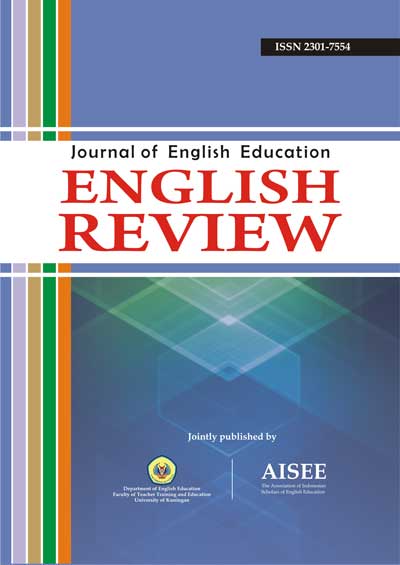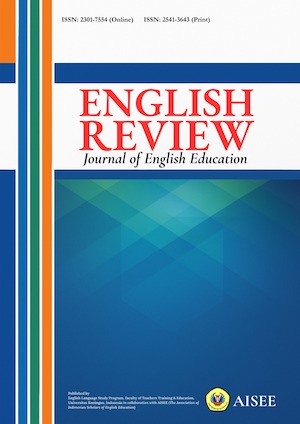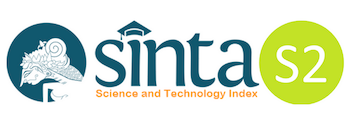THE USE OF PAIR COMPOSITION METHOD ON STUDENTS’ DESCRIPTIVE WRITING SKILL
Abstract
Abstract: This research was aimed to find out roles of pair composition method on students’ behaviour in learning processes and their writing assessment, and also to find out students’ attitude toward learning process of pair composition method in writing descriptive text in the classroom. Descriptive qualitative method was used in this research. The participants were 33 students of X grade of Senior High School. The data were collected from observation, the result of analysis showed that 66% of the seriousness of students during learning process was high, 78% of enthusiasm of students in doing task was high, and 58% of students’ participation was high. The increasing of students’ assessment was 18,7 from the average score before. The data collected from interview and questionnaire indicated that pair composition method provided the opportunities for sharing ideas, developing text, corresting writing errors, motivating students being active, and 50% students strongly agreed that pair composition method on writing descriptive text was lively and enjoyable.
Keywords: Active learning strategy, cooperative learning, pair composition method, descriptive writing, descriptive text.
References
Bashrin, S. D. (2013). Productive skills: Teaching beginners in English medium school. Unpublished report, BRAC university, Dhaka, Bangladesh.
Brown, H. D. (2000). Principle of language learning and teaching. Fourth edition. New York: Addison Wasley Longman, Inc.
Brown, H. D. (2001). Teaching by principle: An interactive approach to language pedagogy. Second edition. New York: Longman
Creswell, J. W. (2009). Design qualitative, quantitative and mixed methods approach, third edition. United States of America: Sage Publication Inc.
Felder, R. M. and Brent, R. (2004). Cooperative learning. National effective teaching institute, 2004, pp. E-1 – E-22.
Felder, R. M. and Brent, R. (2009). Active learning: An introduction. ASQ Higher Education Brief, 2(4), pp. 1-5.
Fraenkel, J. R. and Wallen, N. E. (2009). How to design and evaluate research in education, Seventh edition. New York: McGraw-Hill Companies, Inc.
Gerot, L. and Wignell, P. (1994). Making sense of functional grammar. Sydney: Gerd Stabler.
Heaton, J. B. (1990). Writing English language tests. England: Longman group (FE) Ltd.
Johnson, D. W., Johnson, R. T., & Smith, K. A. (1998). Active learning: Cooperation in the college classroom (2nd ed). Edina, MN: Interaction Book Co.
Knapp, P. and Watkins, M. (2005). Genre, text, Grammar: Technologies for teaching and assessing writing. Sydney: University of South Wales Press.
Oskamp, S, and Schultz, W. P. (2005). Attitudes and opinions (Third Edition). New Jersey: Lawrence Erlbaum Associates, Inc.
Pinter, A. (2006). Teaching young language learners. New York: Oxpor University Press.
Prince, M. J. (2004). Does active learning work? A Review of the Research. J. Engr. Education, 93(3), 223-231.
Sa’diah, H. Improving students’ ability in writing descriptive text through a picture series-aided learning strategy. The English Teacher, vol. XL: 164-182.
Scarino, A. and Liddicoat, A. J. ( 2009). Teaching and learning languages: A guide. Australia: GEON Impact Printing Pty Ltd.
All articles published in English Review: Journal of English Education (ERJEE) are licensed under the Creative Commons Attribution 4.0 International License (CC BY 4.0).
Copyright Ownership
Authors retain the copyright of their articles and grant ERJEE the right of first publication. The journal is granted a non-exclusive license to publish, reproduce, and distribute the article in any format, medium, or platform, provided that proper credit is given to the original authors.
License Terms – CC BY 4.0
Under the Creative Commons Attribution 4.0 International License, others are free to:
- Share — copy and redistribute the material in any medium or format
- Adapt — remix, transform, and build upon the material for any purpose, even commercially
As long as they:
- Provide appropriate credit to the original author(s) and source
- Provide a link to the license (https://creativecommons.org/licenses/by/4.0/)
- Indicate if any changes were made
There are no restrictions on the reuse, reproduction, or adaptation of published articles as long as attribution is properly given.
Author Warranties
By submitting a manuscript to ERJEE, authors confirm that:
- The work is original and does not infringe any existing copyright.
- The manuscript has not been previously published and is not under consideration elsewhere.
- All sources and references are appropriately acknowledged.
- Necessary permissions have been obtained for any copyrighted materials used.










